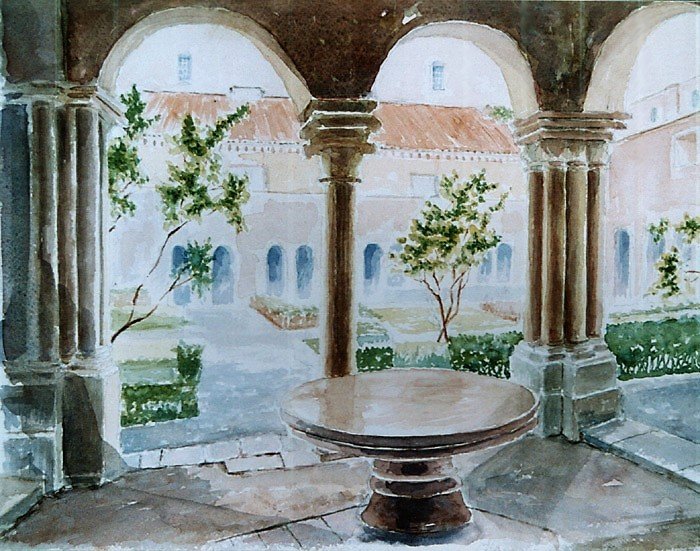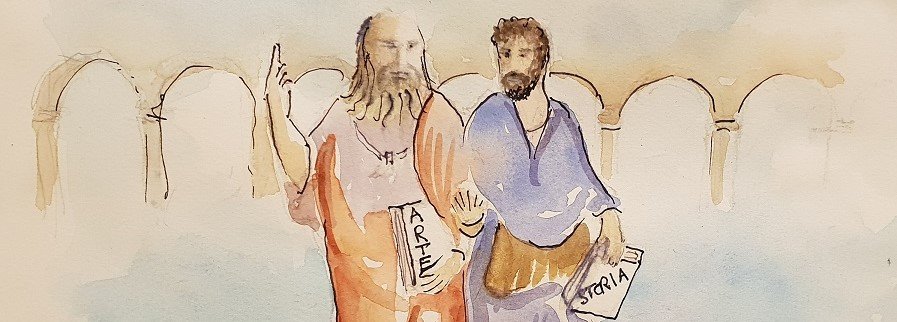
Meditation

2 0 1 8
watercolor - private collection-London
Velocità,
ne siamo circondati e immersi in essa, siamo cacciati dentro, volenti o nolenti, e spesso non riusciamo ad uscirne, un turbinio di ritmi assurdi e ridondanti pervadono la nostra vita, quella di tutti i giorni.Steemit non fa eccezioni,
sarebbe interessante una statistica che attestasse realmente, quanti utenti leggono i post degli altri, e soprattutto in che modo?Facciamo scorrere tutto velocemente, il tempo attuale, individuale, sembra essersi affrancato dal tempo storico, azzerando il tempo fisico.
Tutto è diventato improvvisamente veloce e rapido, dalla lettura al viaggiare, al muoversi freneticamente e addirittura al parlare, nel fare domande e nel rispondere vige la rapidità di esecuzione.
Veloci persino nelle attività primarie, il mangiare e il bere, e forse anche nel fare all'amore.
Manca il tempo? Non abbiamo tempo?
Ma il tempo è la nostra unità di misura, non quella altrui, il tempo è un nostro indicatore di benessere, probabilmente non siamo più in grado di apprezzarne i benefici, ne abbiamo perso l'essenza.
Il tempo abbraccia, permea e comprende la meditazione e la preghiera, per chi crede, ma anche se non preghi puoi farlo nella maniera elettiva che più ti si addice, come la contemplazione e la riflessione, modalità estetiche e sensoriali che vanno perdendo valore e soprattutto significato.
Aumentano in modo esponenziale le associazioni ed i corsi che portano alla ricerca e al benessere interiore, attraverso degli incontri, meditativi e filosofici.
Ciò è segno che ci manca una auto-regolamentazione interiore, di studio e passione per noi stessi, abbiamo bisogno che lo faccia qualcun altro perchè noi non siamo più capaci a fermarci e guardarci dentro il nostro vivere quotidiano.
Aumentano anche la ricerche disperate di permanenze in clausura, anche di settimane, in antichi e austeri monasteri, tipo full-immersion in un ciclo di conferenze (tanto per ricordare modalità legate alla velocità e frenesie dello stile di vita).
Soffermiamoci, a guardare un fiore, tanto da immaginare di sentirne l'odore o le onde del mare che si susseguono, incantandoci e ammaliandoci come un canto delle sirene, a parlare per una intera notte con un amico.
A sentire il battito della Terra come in Stalker di Tarkovskij, prima della fine, dentro la Zona.
Ci vorrebbe un chiostro tutti i giorni, ne ho dipinto uno.

Condivido un mio acquarello, frutto di una delle mie tante visite all'abbazia di Fossanova, in provincia di Latina.
Un abbazia Cistercense tra le più famose al mondo, di cui tratterò un post più approfondito prossimamente.
Acquarello che ho dipinto in una mattina di tranquillità, con uno splendido sole, a cui ho dedicato il giusto riconoscimento, riflesso sul tavolo in marmo ubicato all'interno del chiostro cistercense dell'abbazia.
Il chiostro era uno spazio molto importante per l'abbazia o un monastero, un luogo silenzioso e meditativo, dove leggere, pregare e forse discorrere serenamente.
E' uno spazio di forma quadrilatera, circondato da corridoi coperti, spesso arricchiti da colonne, come nel mio acquarello.
Spesso questo spazio aveva una funzione di accrescere il principio meditatativo attraverso il giardino, e per tale motivo in molti casi abbiamo al centro la presenza di un pozzo, o di una fontana.
Il chiostro è il primo vero esempio di connubio elevato tra, l'architettura e ambiente naturale, in nessun altro edificio occidentale struttura e forma di vita appaiono così strettamente connesse ed integrate come nell'ambito monastico, quasi un riferimento all'oriente, dove la cultura della meditazione è primaria.
Abbiamo i primi esempi di chiostri con san Benedetto verso la fine del 6° secolo, e la vita con i suoi monaci, dove ambiente di preghiera e stanza per dormire erano annessi, si connotava già la disposizione degli spazi claustrali.
Probabilmente, secondo gli storici, la caduta dell'impero romano, ha lasciato resti di ville di nobili o consoli, dove poi si sono insediate comunità monastiche, trasformandole minimamente, alle loro esigenze, costruendo ambienti di preghiera interni o accanto all'edificio romano occupato.
Aprendo le pareti perimetrali si veniva a creare un ambiente di preghiera interno, che diviene il chiostro, dal latino claustrum= luogo chiuso, molto interessante notare che in spagnolo si dice claustro, in inglese cloister e in tedesco kloister, quindi l'etimologia è comune per tutte le lingue occidentali, quasi a difendere la volontà di chiudersi nella meditazione, ma in mezzo alla natura-giardino , pratica tanto perseguita e mai adottata pienamente ai giorni nostri.
Un abbraccio meditativo.
Armando

Fossanova abbey

2 0 1 8
watercolor private collection - London

Speed,
we are surrounded and immersed in it, we are hunted inside, willy-nilly, and often we can not get out, a whirlwind of absurd and redundant rhythms pervade our life, that of every day.Steemit is no exception,
it would be interesting a statistic that really attested, how many users read the posts of others, and especially how?Everything flows quickly, current time seems to have freed itself from historical time.
Everything has suddenly become fast and fast, from reading to traveling, to moving frantically and even to talking, asking questions and responding quickly to execution.
Quick even in primary activities, eating and drinking, and perhaps even in making love.
Is the time lacking? Do not we have time?
But time is our unit of measurement, not that of others, time is our indicator of well-being, we are probably no longer able to appreciate its benefits, we have lost its essence.
Time embraces, permeates and includes meditation and prayer, for those who believe, but even if you do not pray you can do it in the elective way that suits you, like contemplation and reflection, aesthetic and sensory modalities that are losing value and above all meaning.
The associations and courses that lead to research and to inner well-being, through meetings, meditative and philosophical, increase exponentially.
This is a sign that we lack an inner self-regulation, of study and passion for ourselves, we need someone else to do it because we are no longer able to stop and look into our daily life.
The desperate search for stays in seclusion, even for weeks, in ancient and austere monasteries, like full immersion in a series of conferences (to remember ways related to the speed of lifestyle), also increase.
Let us pause, to look at a flower, so as to imagine smelling or the waves of the sea that follow one another, enchanting and bewitching us like a siren song, talking for a whole night with a friend, listening to the beating of the Earth as in Stalker by Tarkovskij , before the end, inside the mysterious restricted site known as the "Zone".
It would take a cloister every day, I painted one.
I share my watercolor, the fruit of one of my many visits to the Abbey of Fossanova, in the province of Latina.
A Cistercian abbey among the most famous in the world, of which I will discuss a more in depth post soon.
Watercolor that I painted in a morning of tranquility, with a beautiful sun, to which I dedicated the right recognition, reflected on the marble table located inside the Cistercian cloister of the abbey.
The cloister was a very important space for the abbey or a monastery, a quiet and meditative place, where to read, pray and perhaps talk serenely.
It is a space of four-sided shape, surrounded by covered corridors, often enriched by columns, as in my watercolor.
Often this space had a function of increasing the meditative principle through the garden, and for this reason in many cases we have at the center the presence of a well, or a fountain.
The cloister is the first true example of a high union between architecture and the natural environment, in no other Western building structure and form of life appear so closely connected and integrated as in the monastic context, almost a reference to the Orient, where the meditation culture is primary.
We have the first examples of cloisters with St. Benedict towards the end of the 6th century, and life with its monks, where the prayer room and sleeping room were annexed, already characterized the arrangement of the cloistered spaces.
Probably, according to historians, the fall of the Roman empire, has left the remains of villas of nobles or consuls, where then monastic communities have settled, transforming them in the least, to their needs, building interior prayer environments or next to the busy Roman building .
Opening the perimeter walls we created an interior prayer room, which becomes the cloister, from the Latin claustrum = closed place, very interesting to note that in Spanish it is called claustro, in English cloister and in German kloister, so the etymology is common for all the western languages, as if to defend the will to close oneself in meditation, but in the middle of the nature-garden, a practice so much pursued and never fully adopted in our day.
A meditative hug.
Armando



discovery-it
@discovery-it

Vieni a trovarci sulla prima rivista dedicata al mondo dell'arte&storia

